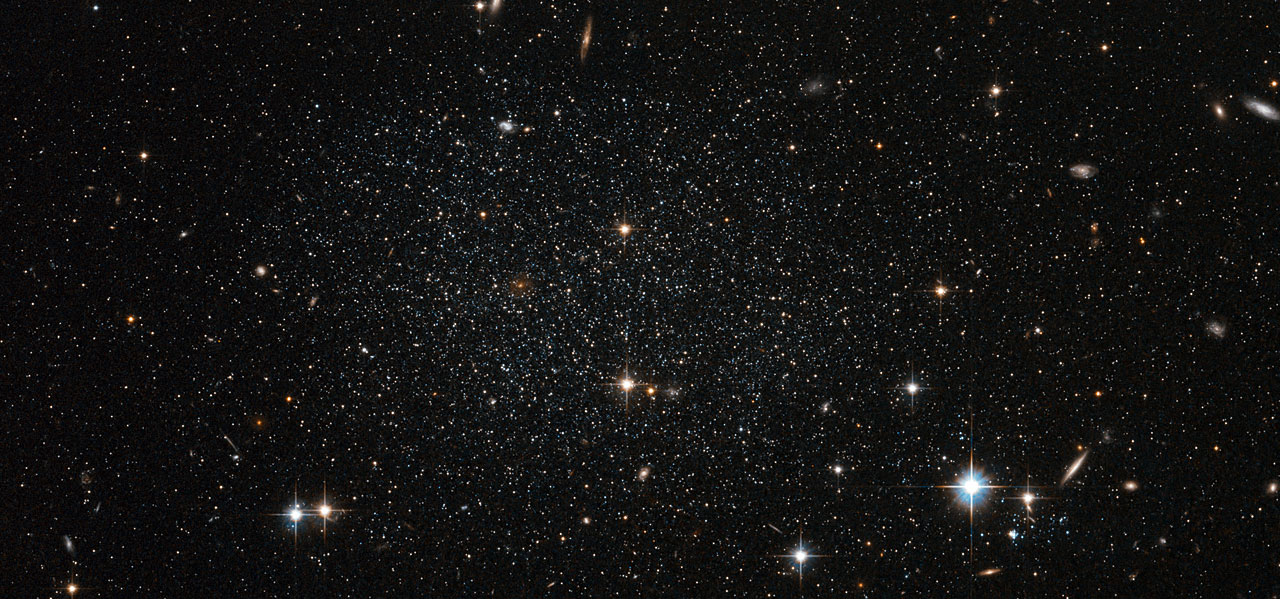This is a galaxy? Yup. It is!
This is the dinky Antlia Dwarf Galaxy (located in the southern constellation of Antlia, the "pump"), technically called a dwarf elliptical. It’s so faint and sparse that it wasn’t discovered until 1985 (and confirmed as being a galaxy in 1997), even though it’s only 4 million light years from Earth… not terribly farther than the Andromeda Galaxy, which is so big it’s visible to the naked eye! Antlia may be a member of the Local Group, a loose collection of a few dozen mostly small nearby galaxies; the Milky Way and Andromeda are the two biggest members.
This image is from Hubble, and shows just how dim a bulb this galaxy is. It only has a few million stars in it — our Milky Way has over a hundred billion, by comparison — and it’s only a few thousand light years across. The Milky Way is a full 100,000 light years in diameter, so if you put Antlia next to it you’d probably miss it entirely. Note that in this picture you’re only seeing the brightest stars in Antlia. At this distance, a star like the Sun in Antlia would be a tough object to see, even with Hubble. Most of the stars you see here are red giants, stars near the ends of their lives and thousands of times more luminous than the Sun.
But it’s an intriguing little bugger. For one thing, some of its stars are clearly very old, ten billion years or so. But other stars are just as clearly young, having been formed only a hundred million years ago or so (and
I found a paper claiming it may have younger stars yet). That means Antlia has had more than one episode of star birth… but it doesn’t appear to be actively churning out stars now. If it did, the bright pinkish-red nebulae that form stars would be really obvious, especially in a galaxy this close by (like in, say,
NGC 1427A).
Interestingly, there’s another galaxy near Antlia:
NGC 3109, a patchy spiral somewhat smaller than the Milky Way. There’s some evidence the two have recently interacted in some way. The disk of the bigger galaxy is warped, which can happen when galaxies poke at each other gravitationally, for one. For another, both galaxies have neutral hydrogen gas in them — not visible in either picture here, since you need radio telescopes to see it in this case — and in NGC 3109
there is an extended plume of gas pointing more or less toward the Antlia galaxy, and moving at the same speed as Antlia. That’s pretty suspicious indeed, and the simplest explanation is they had a close encounter maybe a billion years ago.
It’s interesting that the encounter happened so long ago, but Antlia had an episode of star formation 100 million years ago. Sometimes galaxy collisions can trigger star birth, but that delay is long enough to make me think they’re unrelated. So what triggered the star birth?
Beats me. I did a literature search — I got kinda carried away looking into this galaxy while writing this post — and there’s very little work that’s been done on it. I’m not surprised; Antlia’s a recent discovery and faint. Maybe over time more astronomers will observe it, and we’ll get a better picture of this nearby diminutive galaxy, and get a better idea of its history.
